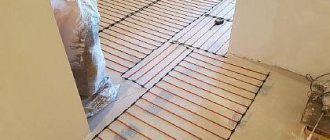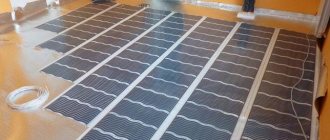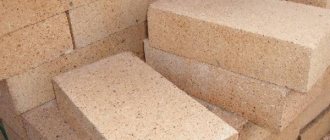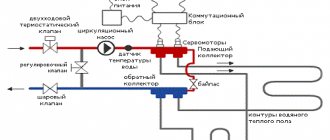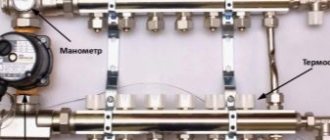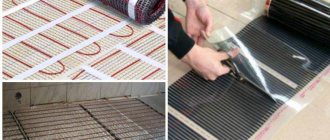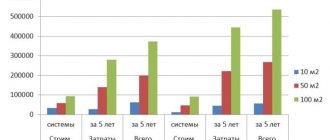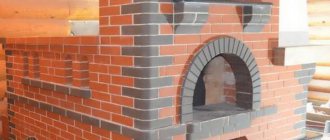Warm floors are gaining popularity, and this is no coincidence, because they create comfort in the home without taking up useful space. For this heating system, devices are used that can limit the temperature of the coolant to no more than 55 degrees.
But such designs take up a lot of space and are intended for arranging heated floors in large rooms. They are not intended for small ones (bathtub, toilet), so for them it is recommended to install a simplified device - a unibox.
From our article you will learn what a unibox for heated floors is, what its purpose is, how it works, and how to install it when installing a hydrofloor in a residential building.
Purpose and main elements
A manifold cabinet for a heated floor will hide the manifold from prying eyes. Here the connection of heating pipes and other heat supply elements is made. In addition, there are adjustment devices there.
Having connected the cabinet, install the supply and return pipes. The supply pipe provides hot coolant coming directly from the boiler. And the return one accumulates water that gave off heat during heating. She returns back to the boiler and heating begins again.
Regular movement of water is supplied by a dedicated pump. In the installed cabinet, a shut-off valve is fitted to each pipeline. When a situation arises that it is necessary to remove several elements from the system (due to repairs or due to savings), heating does not affect the remaining parts of the house. Only one thing needs to be done - turn off both taps.
The joining of a plastic pipeline and a steel valve is carried out using a special compression part - a fitting.
Manifold cabinets are metal devices in the middle of which the floor and water supply mechanism is located. The main purpose of the collector is to independently control the circulation of the coolant, and is also able to provide the floor with the required temperature.
The main parts of the cabinet are:
- body – a box consisting of stainless metal or strong plastic; there are models with the absence of a back wall or one of its sides; on the sides of the structure and its bottom panel there are slots for connecting pipes;
- fastening mechanism - the system is determined by how the structure will be located - on the surface or in the center of the wall; spacers or anchors are often used for fastening; in certain structures, brackets and adjustable clamps are fixed inside;
- door – protects the spacious cabinet from violations and prohibited entry; secured with hinges, equipped with a lock or latch; Many models can be purchased in white or beige, but if desired, it is possible to find other colors.
This structure can be made with your own hands. But, the cost of many devices is not too high, so it’s better not to bother and buy it in a store.
Features and Benefits
The manifold cabinet is a closed metal structure with a removable or fixed door, used to house the connection unit for heating pipes (including supply and return lines), control devices, shut-off and control valves. Such devices have an attractive appearance and successfully hide and protect all internal contents. In addition to heating equipment, the product can contain meters that monitor water supply or the operation of other plumbing or electrical appliances.
Manifold cabinets are mounted in close proximity to the floor. They are installed strictly vertically. It is not recommended to raise the distribution unit higher than 70 cm from the floor covering; the closer it is to the level of the pipes in the screed, the more efficiently the system will work. As a rule, the structure is placed in the room closest to the heating boiler, in an inconspicuous area. If there is no separate room or there is a need to hide several collector units inside, the cabinet is installed in the middle of the room. During installation, the level of raising the floor level after completion of all heating and finishing work is taken into account.
Regardless of the location of the cabinet, access to the door with internal filling remains free.
In the standard version, the manifold cabinet consists of:
- durable plastic or metal frame with slots for supplying communications;
- fastening systems for securely fixing the body inside a niche or on a wall;
- doors with an internal lock or latch to protect the system from children or unauthorized access.
Criteria for choosing lockers for changing rooms, types of models
The advantages of using collector structures in comparison with open wiring are obvious: all the necessary devices are placed at one point without damaging the interior, are protected from external influences, and are available for inspection or repair. Water heating with this scheme remains safe and functions as usual. Installing the distributor at the desired point can significantly reduce the consumption of water floor pipes.
Advantages
The manifold heating cabinet has the following features:
- the use of a distribution overhead structure can significantly reduce the number of pipes required to connect a heated floor; they do not need to be pulled from the heater, because the collector can be placed in the same room;
- In addition to installing a collector, this cabinet can also serve for water supply; it houses a water metering device;
- the cabinet mechanism provides the most convenient access to the guide system for repairs and modernization;
- and most importantly - safety, a turnkey door will be able to protect the building from children, and they, in turn, will not get burned.
In addition, a neatly painted door looks much more beautiful than a bunch of pipes and valves installed on the wall.
Varieties
There are 2 types of manifold cabinets:
- built-in devices - placed in a niche made in the thickness of the wall or hidden under a lining of plasterboard or lining. Typically, the sides of these models are not painted, since they contain outlet and fastening spans. Typically, the depth of the device is 120 mm, the width is 465-1900 mm, and the height is almost 650 mm. To simplify the designation on the niche and to accommodate different sizes of manifolds in the cabinet, certain built-in devices are equipped with retractable legs. Using this option, it is possible to raise the height of the structure to 100 mm;
- external manifold cabinet - these models are the easiest to install, as they are mounted on the wall surface. On the sides, the structure is coated with a special corrosion-resistant agent or powder paint. The outlet slots are initially covered with easily removable metal plates. The external wall-mounted manifold cabinet has dimensions almost identical to the parameters of the built-in structures. It is also possible to adjust the height using extension legs.
Built-in wardrobes are in greatest demand, because they are unnoticeable, do not overshadow the appearance of the room, and are easy to use. The cabinets are painted white; for the built-in ones, only the front panel is decorated. Strong locks are placed on the doors to prevent unauthorized entry into the system.
Built-in
Outer
Distribution (collector) cabinet ShRV, ShRN
Distribution (manifold) cabinets are available in two different modifications:
- Built-in distribution cabinets. This type of manifold cabinets is used for hidden installation in heating systems and water supply systems. Built-in manifold cabinets can also be installed in a special opening or wall niche under tiling;
- External distribution cabinets. Manifold cabinets of this type are mounted externally on the floor or close to the wall surface.
Whatever collector cabinet you choose - an external distribution cabinet (SHR) or an internal distribution cabinet (SHR), the installation of this unit will allow you to optimally mask the collectors. The neutral white manifold cabinet (ШРН, ШРВ) does not attract unnecessary attention, looks quite aesthetically pleasing and does not spoil the appearance of the room with its appearance.
Tips for box location
In the room, a place is selected to install the cabinet, and for collections of floor pipes, they should have approximately the same length - 70 cm. The collector is hidden in a cabinet that has a metal box (or made of strong plastic), it is attached to the wall in a recess. In the middle there are vertical bars that align with the width of the main device. It is used to connect circuits and other elements of the room’s heat supply, and install additional equipment.
The cabinet for the heated floor manifold is connected taking into account the increase in the floor to the point of the thickness of its layers.
Having secured it, introductory hot water and return water are carried out. The supply pipe serves to supply hot media from the general central heating system. The return water is responsible for removing cooled water in the heating device, where it is heated again.
Fastening technique
Each type of manifold cabinet has its own mounting nuances, which are worth remembering when installing them.
Built-in
If the deepening was made during construction, there will be no difficulties with installation. When planning a heated floor and installing a cabinet, carry out the following actions:
- selecting a location for the collector, which is assembled no lower than the floor height, since problems with heat supply are possible;
- mark the wall for pipe collections;
- using a wall chaser to make holes for a cabinet or pipeline;
- The structure is fixed into the wall niche and connected with anchors on the sides of the box;
- place the collector, fasten the circuits and heat supply;
- the gap between the cabinet and the wall is covered with mortar, then puttied.
Preparing the installation site
Installation
Outer
Installation is a little easier:
- select a location for the structure;
- place the box;
- aligned according to the drawn marks;
- drill holes for anchors with a hammer drill, screw the box together with screws;
- install the collector, connect the circuits;
- the wall remains the same - the cladding is not touched.
The cabinets are installed quickly. The recess does not delay the fastening process. After connection, there will be no problems with adjusting the system and water supply.
Installation nuances
When choosing the exact location of the manifold cabinet, you should consult with professionals. Errors at this stage are fraught with overuse of pipes or deviation of pressure indicators in the heating system from the optimal value. The best results are achieved when installing the cabinet in the middle point of the room, near the floor surface. Special requirements are put forward for the evenness of the working base. The structures holding the manifold cabinet must not be level.
The mounting pattern depends on the type of cabinet. Built-in models are installed after marking and laying grooves with mandatory fixation of anchors on the outer sides of the box. After installing the collector, the heating circuit is finally closed and its tightness is checked. If there are no leaks or pressure drops, possible gaps between the cabinet and the walls are covered with mortar or putty.
Main characteristics of medical cabinets, types and purpose of furniture
Wall-mounted varieties are much easier to install. The anchor attachment points are marked on the walls, and the cabinet frame is fixed with screws. By analogy with built-in models, a trial start of heating becomes possible after installation is completed. Regardless of the chosen type of design, when placing the collector inside the cabinet, you should remember the need to ensure maximum tightness of connections and protection of control devices . A detailed installation diagram drawn up in advance, taking into account the dimensions, features of the cabinet and the location of communications, helps to avoid mistakes.
Prepare the mounting location according to the diagram
Install the cabinet, connect the heating system and check it, cover any gaps between the wall and the cabinet
Design sizes and popular manufacturers
The best producers are:
- the Russian company Grota produces devices at competitive prices from 1466-3454 rubles;
- the Italian company Valtec offers cabinets priced from 1600-4600 rubles;
- The Russian company Wester produces structures for 1523-3588 rubles.
The built-in manifold cabinet has the dimensions shown in the table.
| Designation | Dimensions | Manufacturers | Price |
| ShV-1 | 670×125×494 | Grota | 1614.00 |
| ShV-1 | 648-711×120-180×450 | Wester | 1713.00 |
| ShV-2 | 670×124×594 | Grota | 1789.00 |
| ShV-2 | 648-711×120-180×550 | Wester | 1900.00 |
| ShV-3 | 670×125×744 | Grota | 2108.00 |
| ShV-3 | 648-711×120-180×700 | Wester | 2236.00 |
| ShV-4 | 670×125×894 | Grota | 2445.00 |
| ShV-4 | 648-711×120-180×850 | Wester | 2596.00 |
| ShV-5 | 670×125×1044 | Grota | 2963.00 |
| ShV-5 | 648-711×120-180×1000 | Wester | 3144.00 |
| ShV-6 | 670×125×1194 | Grota | 3207.00 |
| ShV-6 | 648-711×120-180×1150 | Wester | 3403.00 |
| ShV-7 | 670×125×1344 | Grota | 3981.00 |
The external manifold cabinet has dimensions that are presented in the table.
| Designation | Dimensions | Manufacturers | Price |
| SHN-1 | 651-691×120×454 | Grota | 1466.00 |
| SHN-1 | 652-715×118×450 | Wester | 1523.00 |
| SHN-2 | 651-691×120×554 | Grota | 1558.00 |
| SHN-2 | 652-715×118×550 | Wester | 1618.00 |
| SHN-3 | 651-691×120×704 | Grota | 1846.00 |
| SHN-3 | 652-715×118×697 | Wester | 1919.00 |
| SHN-4 | 651-691×120×854 | Grota | 2327.00 |
| SHN-4 | 652-715×118×848 | Wester | 2325.00 |
| SHN-5 | 651-691×120×1004 | Grota | 2507.00 |
| SHN-5 | 652-715×118×998 | Wester | 2603.00 |
| SHN-6 | 651-691×120×1154 | Grota | 2878.00 |
| SHN-6 | 652-715×118×1147 | Wester | 2990.00 |
| SHN-7 | 651-691×120×1304 | Grota | 3454.00 |
| Shn-7 | 652-715×118×1300 | Wester | 3588.00 |
After completing the installation of the overhead structure, adjustments and branches, it is necessary to do a test run, heating the system to detect defects or malfunctions. In addition, you should induce operating pressure in the device by about 25 percent, exaggerating the pressure during casual operation, and take a good look at the tightness of the joints.
